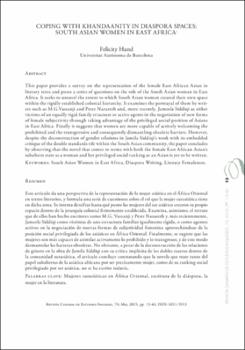Coping with Khandaanity in Diaspora Spaces: South Asian Women in East Africa
Author
Hand, FelicityDate
2015Abstract
Este artículo da una perspectiva de la representación de la mujer asiática en el África Oriental en textos literarios, y formula una serie de cuestiones sobre el rol que la mujer surasiática tiene en dicha zona. Se intenta descifrar hasta qué punto las mujeres del sur asiático crearon su propio espacio dentro de la jerarquía colonial firmemente establecida. Examina, asimismo, el retrato que de ellas han hecho escritores como M.G. Vassanji y Peter Nazareth y, más recientemente, Jameela Siddiqi como víctimas de una estructura familiar igualmente rígida, o como agentes activos en la negociación de nuevas formas de subjetividad femenina aprovechándose de la posición social privilegiada de los asiáticos en África Oriental. Finalmente, se sugiere que las mujeres son más capaces de asimilar activamente lo prohibido y lo transgresor, y de este modo desmantelar las barreras obsoletas. No obstante, a pesar de la deconstrucción de las relaciones de género en la obra de Jamila Siddiqi con su crítica implícita de los dobles raseros dentro de la comunidad surasiática, el artículo concluye constatando que la novela que trate tanto del papel subalterno de la asiática africana por ser precisamente mujer, como de su ranking social privilegiado por ser asiática, no se ha escrito todavía. This paper provides a survey on the representation of the female East African Asian in literary texts and poses a series of questions on the role of the South Asian woman in East Africa. It seeks to unravel the extent to which South Asian women created their own space within the rigidly established colonial hierarchy. It examines the portrayal of them by writers such as M.G.Vassanji and Peter Nazareth and, more recently, Jameela Siddiqi as either victims of an equally rigid family structure or active agents in the negotiation of new forms of female subjectivity through taking advantage of the privileged social position of Asians in East Africa. Finally it suggests that women are more capable of actively welcoming the prohibited and the transgressive and consequently dismantling obsolete barriers. However, despite the deconstruction of gender relations in Jamila Siddiqi’s work with its embedded critique of the double standards rife within the South Asian community, the paper concludes by observing that the novel that comes to terms with both the female East African Asian’s subaltern state as a woman and her privileged social ranking as an Asian is yet to be written.





